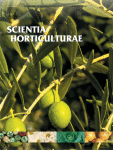Ver ítem
- xmlui.general.dspace_homeCentros Regionales y EEAsCentro Regional Mendoza - San JuanEEA La ConsultaArtículos científicosxmlui.ArtifactBrowser.ItemViewer.trail
- Inicio
- Centros Regionales y EEAs
- Centro Regional Mendoza - San Juan
- EEA La Consulta
- Artículos científicos
- Ver ítem
Assessment of genetic diversity and population structure in a garlic (Allium sativum L.) germplasm collection varying in bulb content of pyruvate, phenolics, and solids
Resumen
This study characterized genetic diversity in the Argentine garlic germplasm bank by analysis of 10 SSR loci in 73 garlic accessions. A total of 43 alleles and polymorphic information content (PIC) value of 0.38, along with various accessions that could not be differentiated with these SSR markers, suggest a relatively high level of genetic redundancy in this garlic collection. Nonetheless, cluster analysis using different methodologies (UPGMA, STRUCTURE,
[ver mas...]
This study characterized genetic diversity in the Argentine garlic germplasm bank by analysis of 10 SSR loci in 73 garlic accessions. A total of 43 alleles and polymorphic information content (PIC) value of 0.38, along with various accessions that could not be differentiated with these SSR markers, suggest a relatively high level of genetic redundancy in this garlic collection. Nonetheless, cluster analysis using different methodologies (UPGMA, STRUCTURE, and PCoA) consistently and clearly separated these germplasm into four clusters. The garlic accessions were clustered in general agreement with their flowering behavior, botanical variety, ecophysiological group, and commercial bulb color-type. Two SSR markers strongly associated with the flowering phenotype (i.e., bolting vs. non-bolting) and ecophysiological group of the accessions were identified. In addition to the genetic analysis, the garlic accessions were characterized for their bulb content of solids, total organosulfur compounds (estimated by analysis of pyruvate levels) and total phenolic compounds, three groups of compounds associated with garlic’s flavor (pungency), nutraceutical value, and postharvest quality. Significant (p < 0.001) and broad variation was found among the accessions for all three phytochemicals, and garlic genotypes with high levels of these compounds were identified. These results suggest that it will be possible to select for mild and pungent garlics, as well as for garlics with high functional value and longer shelf-life. Significant variation was revealed for phytochemicals content among different classes of botanical variety, flowering behavior and ecophysiological group.
[Cerrar]

Fuente
Scientia Horticulturae : 108900 (Available online October 2019)
Fecha
2019-10
Editorial
Elsevier
ISSN
0304-4238
Formato
pdf
Tipo de documento
artículo
Palabras Claves
Derechos de acceso
Restringido
 Excepto donde se diga explicitamente, este item se publica bajo la siguiente descripción: Creative Commons Attribution-NonCommercial-ShareAlike 2.5 Unported (CC BY-NC-SA 2.5)
Excepto donde se diga explicitamente, este item se publica bajo la siguiente descripción: Creative Commons Attribution-NonCommercial-ShareAlike 2.5 Unported (CC BY-NC-SA 2.5)

